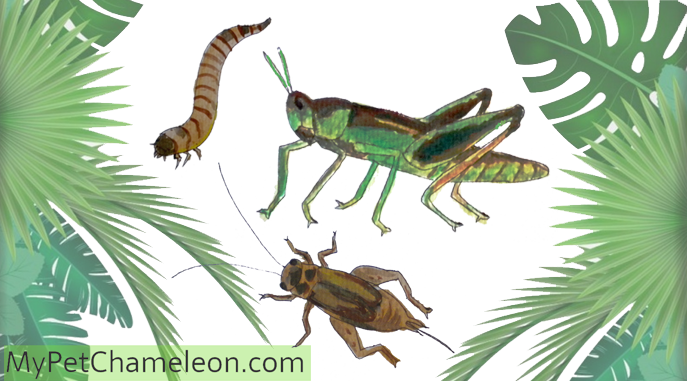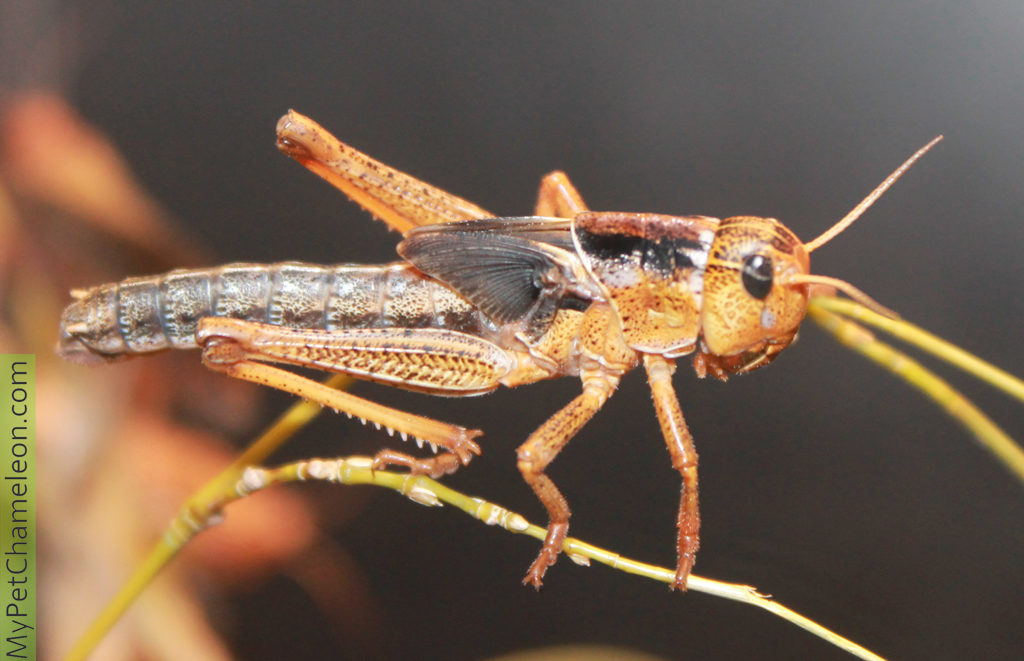
To keep your pet chameleon healthy and happy, it should be fed an healthy diet of proper chameleon food. A veiled chameleon mostly eats all kinds of insects. It will also eat fruits and vegetables. Because the food we give them in captivity generally does not have enough calcium and vitamin D we can supplement the food with extra vitamins and calcium. On this page you can read all about healthy food for chameleons.
Chameleon food: Live insects
Many species of live insects are excellent food for chameleons. Especially:
- Crickets
- Grasshoppers
- Caterpillars
- Moths and butterflies
- Meal worms
- Morio worms
- Katydids and mantises
- Stick insects
- Cockroaches
- Pink baby mice
Not all these kinds of insects are harmless, you can find poisonous caterpillars, butterflies or other insects in nature. Pet shop feeder insects are generally safe, they could be sick or have parasites but this is rare.

Taking care of the live feeder insects
You do need to take care of the live insects you feed to your chameleon. If you do not feed them properly, they will not contain as much nutrients for your chameleon. They will also not last as long, making it costly for you to feed your chameleon.
What you feed your feeder insects will directly go into your chameleon. The food that is in the gut of the feeder insects will be eaten by your chameleon. A feeder insect that has not eaten in a while will not contain as much nutrient as a healthy one that has eaten healthy food. This is called gut loading, you can read more about that here. Crickets and cockroaches can be fed with fruits, green vegetables, oatmeal, cricket food, raw potato or special food pellets. Provide them with a source of water that will not let them drown, like a sponge on a plate or a piece juicy fruit. Grasshoppers can be fed with grass or green reeds, they need a dry environment with fresh greens for their moisture.
If you buy feeder insects at a pet shop you can better not keep them in the container that you got them in. Transfer them to a bigger enclosure, like a plastic box or fauna box, and provide them with some egg cartons to hide under, and some food and moisture. To read more about that, check out the page Keeping feeder insects alive and healthy.

The right size of feeder insects for your chameleon
A baby veiled chameleon cannot eat what an adult veiled chameleon eats. It’s much too big! A baby veiled chameleon will start its live eating small crickets and Drosophila hydei fruit flies. An adult chameleon will eat large Egyptian grasshoppers and adult cockroaches. So you need to choose the right size of feeder insect for your size chameleon. The general rule is that a chameleon will eat anything that is 1 to 1,5 times the size of its mouth, or smaller.
Fruits and vegetables for chameleons
Chameleons enjoy eating fruits and vegetables, but this is not their staple food. Insects are their most important food item. Fruits and vegetables to provide some extra nutrients, vitamins and moisture that will be healthy for your veiled chameleon. When you feed your chameleon many insects, and many different kinds, it is often not very inclined to eat vegetables and fruits. It is also a personality thing: some chameleons like it, others refuse to eat it. My veiled chameleon loves broccoli but does not accept many other fruits or vegetables.
Try to feed your chameleon fruits and vegetables from a young age. Offer it once a week, even when it does not eat it. It can suddenly decide to start eating it. Cut the items in small pieces to make it easier to eat. Thoroughly wash them to remove any pesticides and peel the fruits with a tough skin. Do not add any salt or other additives except reptile vitamin powder or calcium powder.
The following fruits and vegetables are great for veiled chameleons:
- Tomato
- Cooked broccoli
- Raw broccoli
- Apple
- Banana
- Strawberry
- Mango
- Orange (peeled and in parts)
- Tangerine
- Kiwi
- Melon
- Cabbage (not too much)
- Lettuce
- Cooked peas
- Fresh spinach leaves
- Cooked carrot
How often should I feed my chameleon?
When your chameleon is not yet adult, you can feed it as much crickets, grasshoppers, cockroaches, caterpillars, fruits and vegetables as it will eat. Limit the amount of waxworms, mealworms and morio worms you feed to it as those are very fatty. A chameleon that is still growing will eat a lot, often more than you would expect. Make sure you have enough food for it. A veiled chameleon that is between 3 and 8 months old will eat a whole box of crickets in around 5 days. When the chameleon stops growing it will eat much less. It will eat maybe 3 to 5 crickets a day, or two grasshoppers. When producing eggs the food intake will go up again.
An adult chameleon does not need to eat every day. You could skip a day. I am a proponent of feeding your chameleon at least a little bit every day. Sometimes it will refuse all food for a day or two, this is normal and you should not worry about it.
Adding calcium and vitamins to chameleon food
You should supplement this food with extra calcium and vitamins. How to add this to the food and how much you should give is all explained here.
